Asus is one of the few manufacturers that still offers compact Android smartphones in the premium segment. The new Zenfone 9 scores with size, performance, camera and battery life. At 799 euros, the price has risen significantly compared to the previous year and there are definitely strong competitors in the compact smartphone segment.
Table of contents
- 1 Compact powerhouse packs a lot instead of making a mess
- Market launch on August 15 from 799 euros
- Technical data at a glance
- Compact design with good workmanship< /li>
- Power button supports swipe gestures
- 5.9-inch OLED display with 120 Hz
- Screen breaks the 1,000 cd/m² mark
- Android with one-hand mode
- Size limits performance somewhat
- High performance mode gets very hot
- Very fast flash storage
- Battery ensures long runtimes
- 7 hours of screen-on time with 20 hours of use
- Charging only with a cable at 30 watts
- 3 dual camera with gimbal stabilization
- The Zenfone 9 takes beautiful photos
- Video mode with good stabilization
- HDR modes cause confusion
- 4 Conclusion
< li>2 Performance, benchmarks and battery runtimes
With the Zenfone series, Asus is one of the last providers of compact Android smartphones. The Zenfone 9 again relies on compact dimensions and, in comparison to the Zenfone 8, improves on the equipment. The following overview shows where the newest competitor ranks in comparison to other smaller smartphones. Asus does not have the market for itself, as the similarly sized Galaxy S22 (test) shows. And with the iPhone 13 mini (test), which is only 131 mm high, Apple is in a league of its own that no competitor in the Android segment has come close to.
Market start on August 15 from 799 euros
Asus has been offering the Zenfone 9 for pre-order since its July 28 launch. The starting price of 799 euros is a whopping 130 euros more than the 669 euros of the Zenfone 8. In the basic configuration, the smartphone offers 8 GB of RAM and 128 GB of storage. For 849 euros, the non-expandable memory is doubled to 256 GB and for 899 euros, the main memory also doubles to 16 GB.
Chromebook for pre-order
Asus has been running a pre-order campaign since July 28, which includes the Chromebook CX1400CNA-BV0170 worth 279 euros for free. The promotion runs until August 31st or while stocks last. According to Asus, the Zenfone 9 will be delivered to customers from August 15th.
Overview of technical data
Asus Zenfone 9 Apple iPhone 13Apple iPhone 13 miniApple iPhone 13 ProApple iPhone SE (2022)Asus Zenfone 8 ✔Asus Zenfone 9 ✔Samsung Galaxy S22 Asus Zenfone 8 Apple iPhone 13Apple iPhone 13 miniApple iPhone 13 ProApple iPhone SE (2022)Asus Zenfone 8 ✔Asus Zenfone 9 ✔Samsung Galaxy S22 Software:
(when released) Android 12.0 Android 11.0 Display: 5.92 inches, 1,080 × 2,400
445 ppi, 120 Hz
AMOLED, HDR, Gorilla Glass Victus Control: Touch , fingerprint sensor, face scanner Touch, fingerprint sensor, face scanner, status LED SoC: Qualcomm Snapdragon 8+ Gen 1
1 × Cortex-X2, 3.20 GHz
3 × Cortex-A710, 2.75 GHz
4 × Cortex-A510, 2.00 GHz
4 nm, 64-bit Qualcomm Snapdragon 888
1 × Kryo 680 Prime, 2.84GHz
3 × Kryo 680 Gold, 2.42GHz
4 × Kryo 680 Silver, 1.80GHz
5nm, 64-bit GPU: Adreno 730
900 MHz Adreno 660
840 MHz RAM: 8,192 MB
LPDDR5 variant 16,384 MB
LPDDR5 memory: 128/256 GB 1. Camera: 50.0 MP, 4320p
LED, f/1.9, AF, OIS 64.0MP, 4320p
LED, f/1.7, AF, OIS 2nd Camera: 12.0 MP, f/2.2, AF 3rd Camera: No 4th Camera: No 5th Camera: No 1st Front Camera: 12.0 MP , 2160p
Display flash, f/2.5, AF 2. Front camera: No GSM: GPRS + EDGE UMTS: HSPA+
↓42.2 ↑5.76 Mbit/s LTE: Advanced Pro 5G: NSA /SA WLAN: 802.11 a/b/g/n/ac/ax
Wi-Fi Direct Bluetooth: 5.2 Positioning: A-GPS, GLONASS, BeiDou, Galileo, QZSS, NavIC Other standards: USB 2.0 Type C, NFC , 3.5 mm jack SIM card: nano SIM, dual SIM battery: 4,300 mAh, 30.0 W
permanently installed 4,000 mAh, 30.0 W
Permanently installed Size (W×H×D): 68.1 × 146.5 × 9.10 mm 68.5 × 148.0 × 8.90 mm Protection class: IP68 Weight: 169 g Price: from €799/from €849 €/from 899 € 669 €/729 €/799 €
Compact design with good processing
Asus offers the base model of the Zenfone 9 in black, blue, red, and white, the larger configuration only in black and white, and the (tested) top model only in black. All four colors combine a new back made of plastic instead of glass, which is matt and has been slightly roughened to provide more grip, which the manufacturer has also succeeded in doing. The aluminum frame that runs around the device is just as matte and has small bulges for areas such as the power button with integrated fingerprint sensor and the 3.5 mm headphone jack.
More space inside
The most important measure for good handling are the dimensions of just 68.1 × 146.5 × 9.10 mm (W × H × D). The smartphone is 0.4 mm narrower and 1.5 mm shorter than the Zenfone 8, but 0.2 mm thicker, so that the overall volume is even slightly higher. Asus hides the additional space for the internal components with an angular design after the Zenfone 8 was slightly curved towards the edges. The Zenfone 9, on the other hand, is a rectangular smartphone that you can even stand without needing a mount.
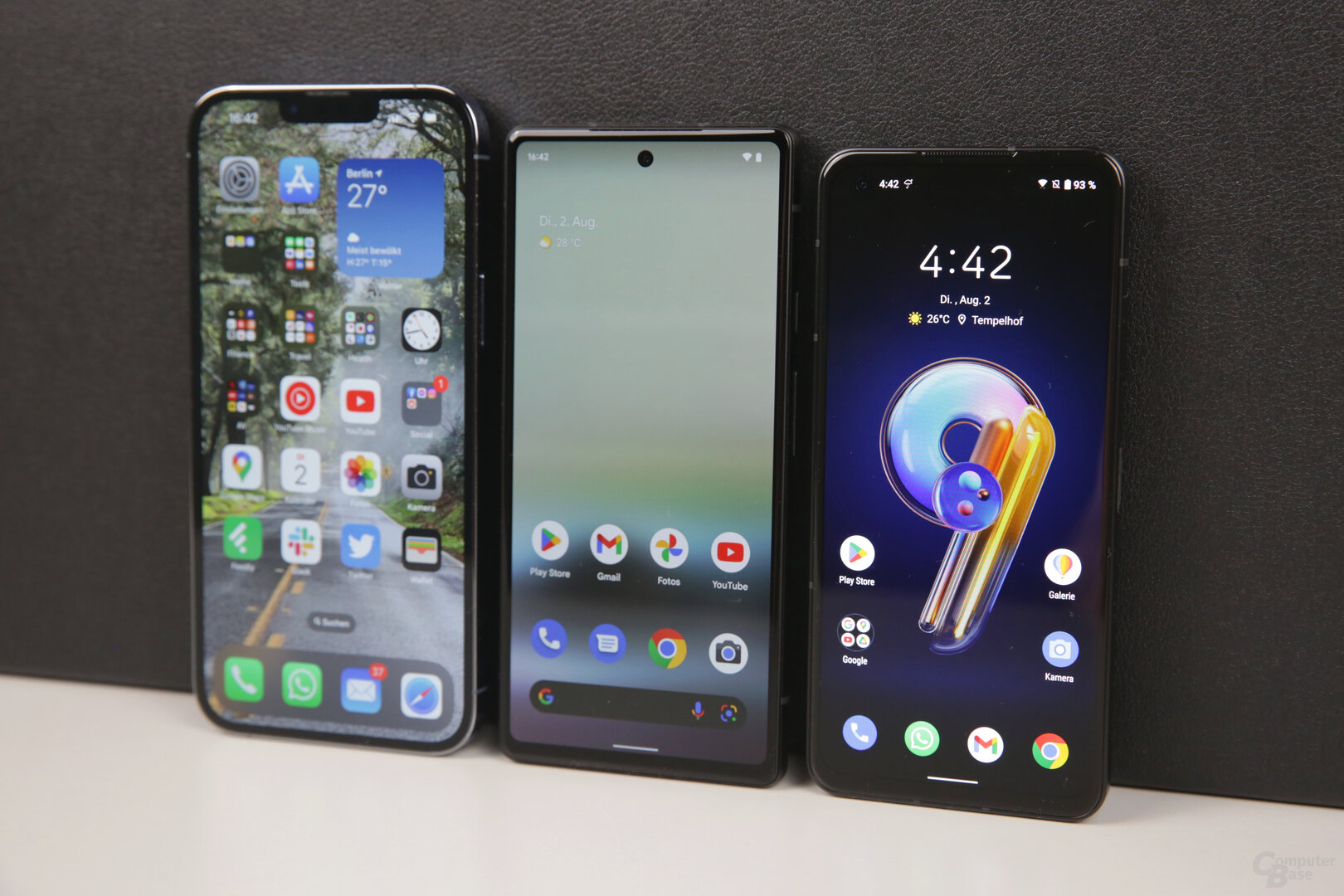 Size comparison with iPhone 13 Pro Max (left) and Pixel 6a (middle)
Size comparison with iPhone 13 Pro Max (left) and Pixel 6a (middle) Image 1 of 4
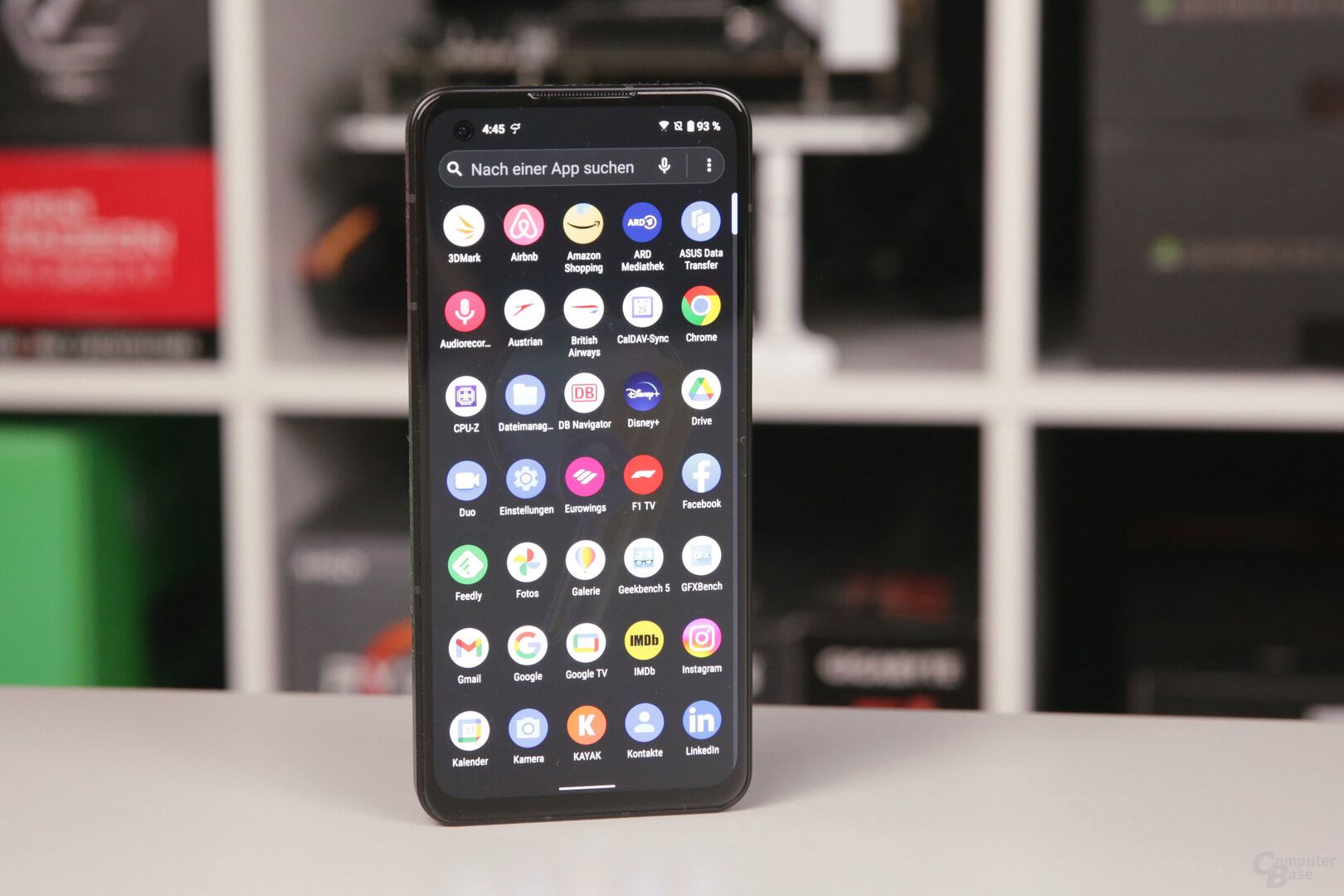 The Zenfone 9 measures 68.1 × 146.5 × 9.10mm
The Zenfone 9 measures 68.1 × 146.5 × 9.10mm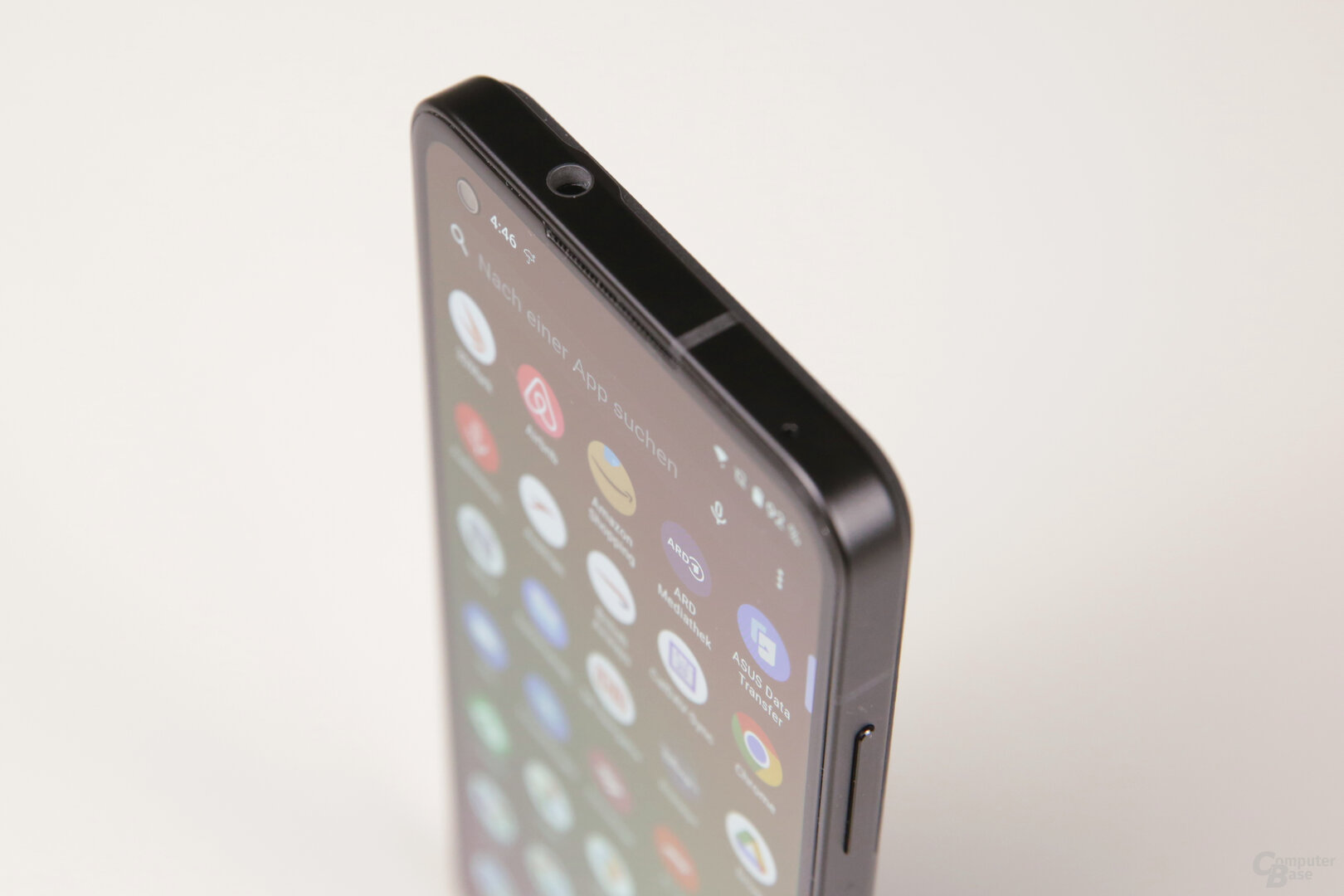 The headphone jack remains
The headphone jack remains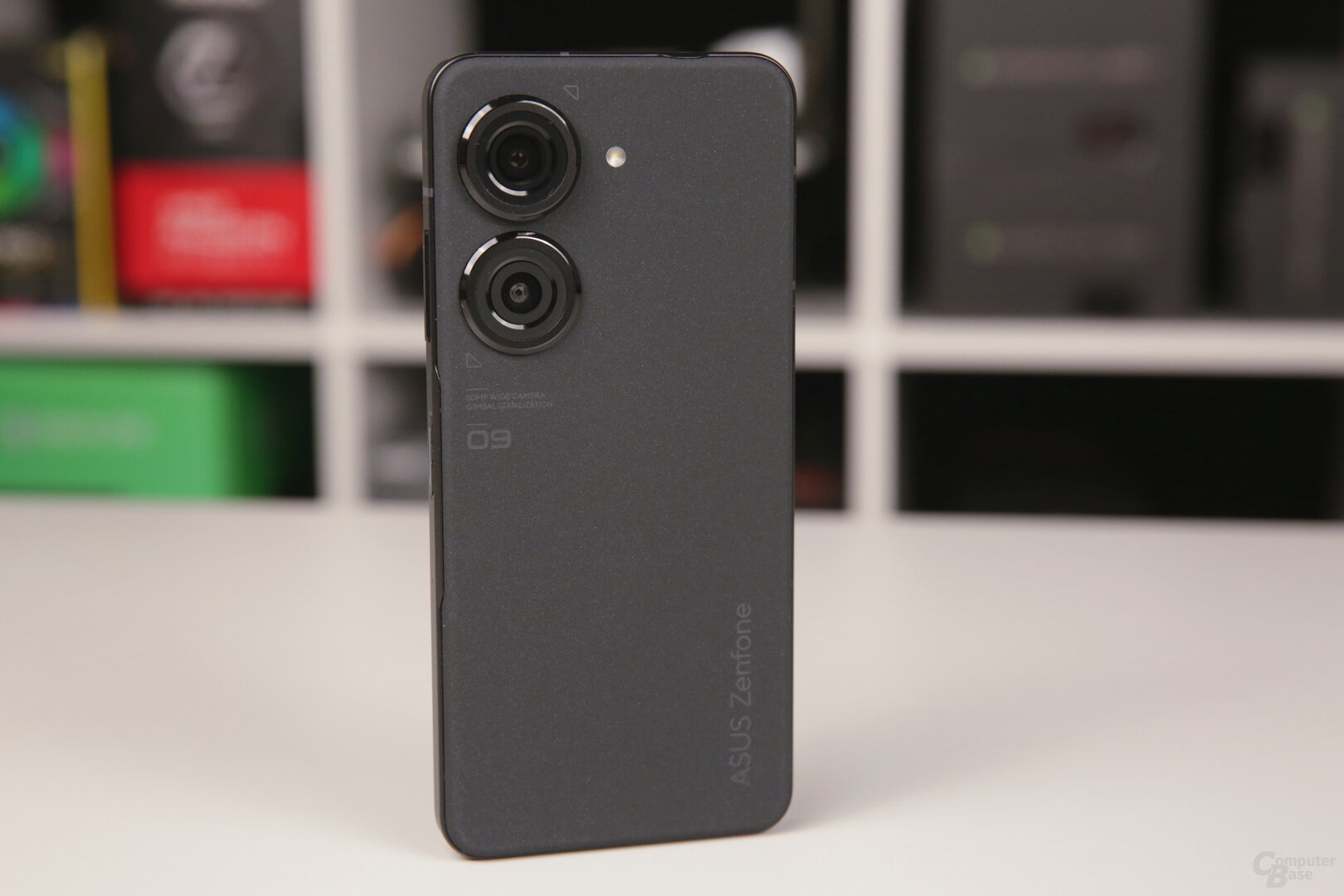 Roughened back for grip
Roughened back for gripThe power button, whose fingerprint sensor can be easily reached with the left index finger or right thumb, contributes to good handling. The volume rocker, on the other hand, would be better placed on the left side of the device instead of installing it above the power button and making it comparatively difficult to reach.
Power button supports swipe gestures
On the other hand, it is extremely practical that the power button also recognizes swipe gestures up and down. For example, the Android menu for quick settings and notifications can be pulled down and closed again. However, the button reacts sensitively and quickly, so that you can trigger an action unintentionally. On the other hand, you have to interact much more intensively with the back, which supports double tapping to start apps or the Google Assistant, for example. In the test, the camera was linked to this action, but don't be too squeamish when knocking.
 The power button also registers swipe gestures
The power button also registers swipe gesturesAlthough Asus uses plastic instead of glass for the back, the workmanship is consistently high quality. The housing is again certified according to IP68 and withstands permanent immersion in water and keeps dust out. Too bad wireless charging didn't make it into the device. Apple and Samsung are the only two manufacturers that offer this feature in the compact segment. The status LED, which was found next to the USB-C socket on the Zenfone 8, is also no longer on board. The always-on display can potentially serve as a not quite adequate replacement.
5.9 inch OLED display with 120 Hz
With 5.9 inches, 1,080 × 2,400 pixels and up to 120 Hz, the screen is a direct continuation from last year without any changes. According to Asus, the same panel is used as in the Zenfone 8, except that the fingerprint sensor has moved to the side. The fact that there is no optical sensor under the display saves installation depth and makes room for components such as a larger battery. Even the glass is the same as 2021 with Gorilla Glass Victus.
-
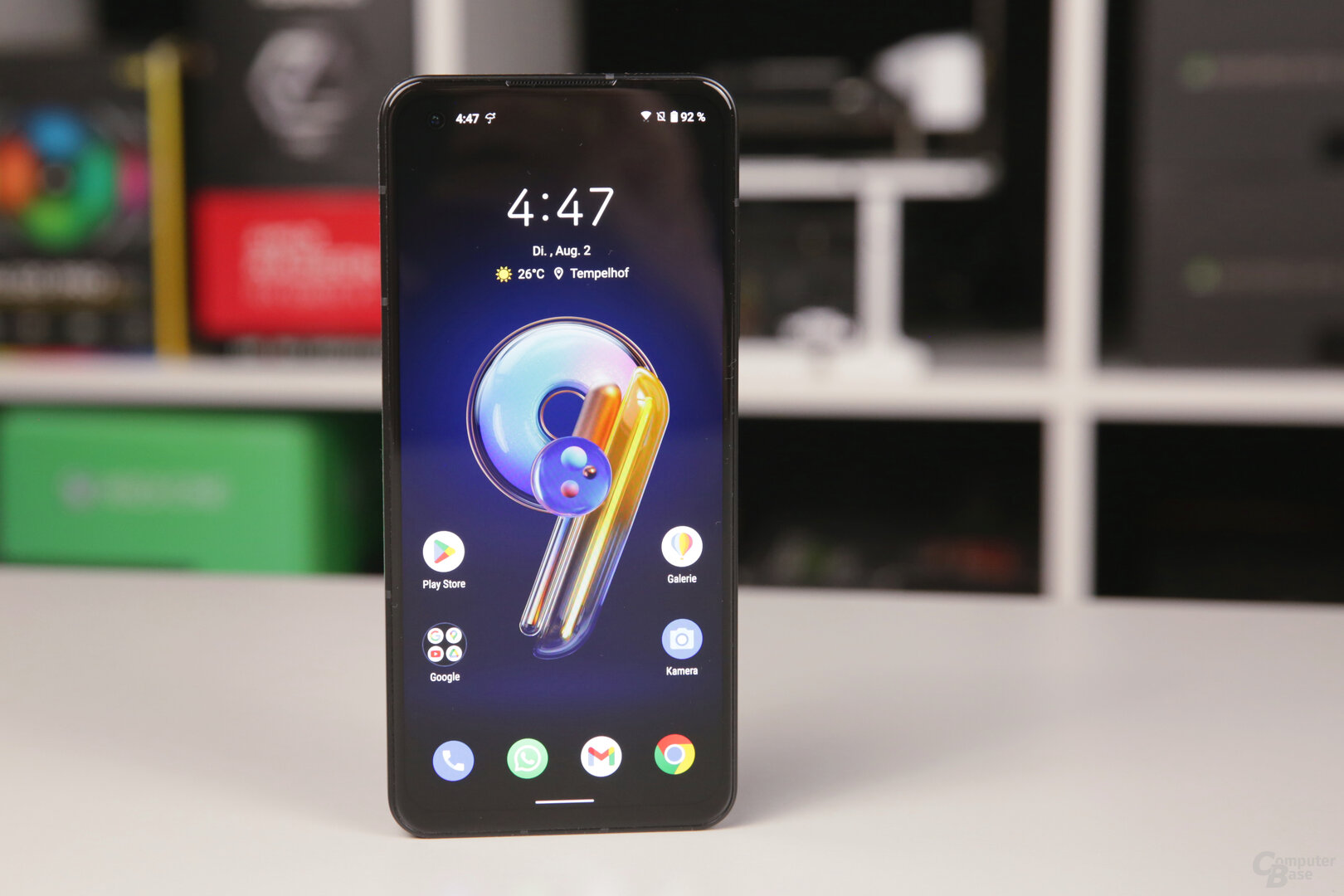 5.9 inch display with 120 Hz
5.9 inch display with 120 Hz
Image 1 of 2
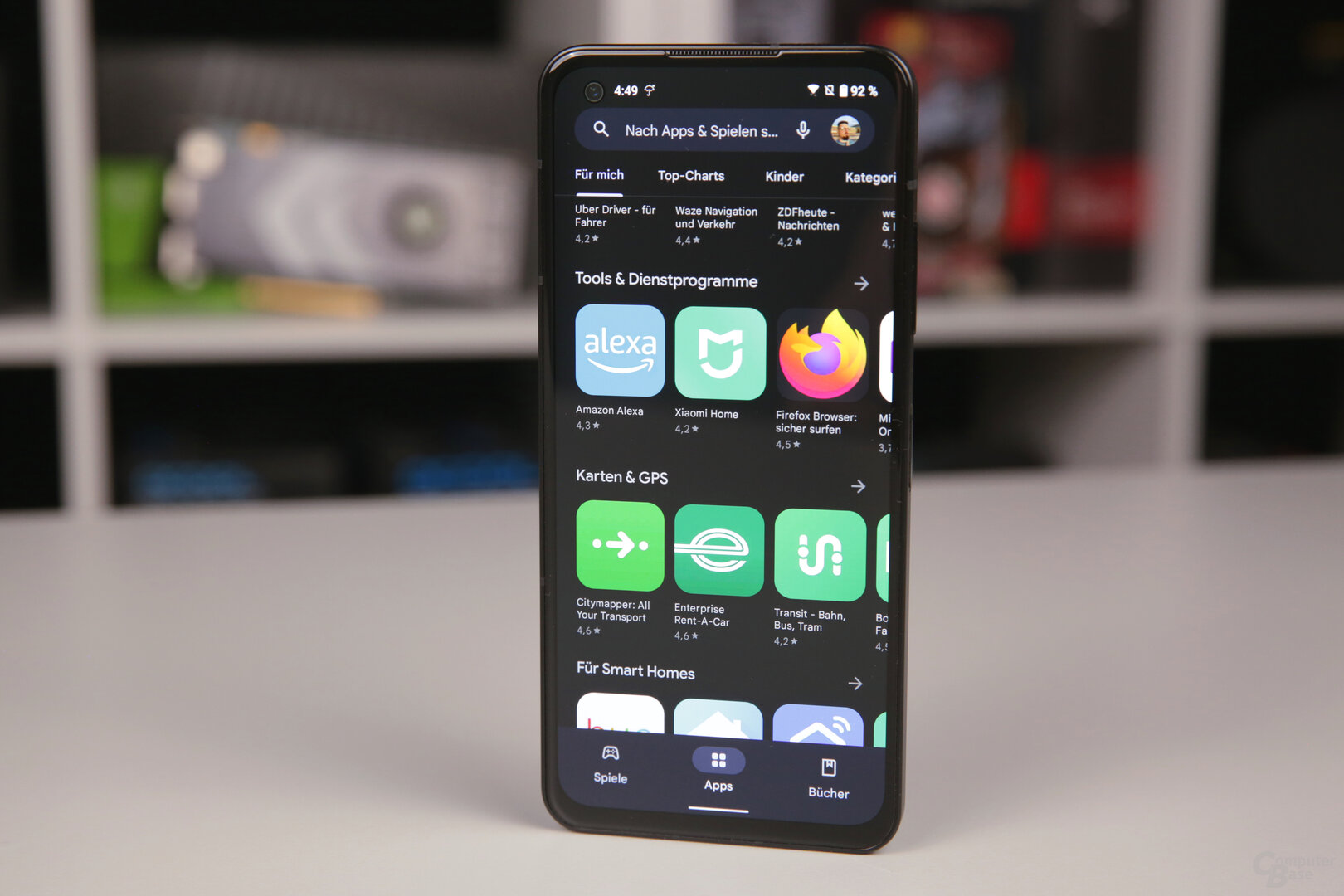 The OLED panel achieved over 1,000 cd/m² in the test
The OLED panel achieved over 1,000 cd/m² in the test< /figure>
In contrast to recently released devices such as the Nothing Phone (1) (test), buyers of the Zenfone 9 have to do without a symmetrical screen bezel and have to be content with a small “chin” at the bottom. Buyers also get a symmetrical OLED display with Apple's iPhone 13 mini (test). Where the notch occupies a lot of space on the Apple, however, a circular recess is used on the Asus, in which the same 12 MP camera of the Zenfone 8 is located, which provides good photos in daylight but does not reach the HDR capabilities in backlight of the primary camera. With Asus, the front camera can also be used for unlocking, but the 2D method is not as secure as the 3D method Face ID from Apple.
Screen breaks the 1,000 cd/m² mark
Asus advertises the screen with 700 cd/m² full screen brightness and up to 1,100 cd/m² at the top. The measured values of the editors match the manufacturer's information, whereby 1,055 cd/m² were possible with an “Average Picture Level” of 10 percent. The “Optimal” mode set at the factory falsifies the image in the direction of a cooler white point. Users are better off with the profiles for sRGB or DCI-P3, which achieve the same brightness values. Anyone who makes manual changes to the panel can always return to the factory settings of the screen with a button.
Charts
- Display brightness max.
- Display brightness min.
- Display contrast
85 entries Display brightness max.
- Automatic mode 100% APL:
- Samsung Galaxy S22+1,182 white point: approx. 6,700
- Samsung Galaxy S22 Ultra 1,161 white point : approx. 6,700
- Apple iPhone 13 Pro1,063White point: approx. 6,800
- Apple iPhone 13 Pro Max1,056White point: approx. 6,300
- Asus Zenfone 9 ( Auto, 10% APL)1,055White point: approx. 7,000
- Asus Zenfone 9 (Auto, 20% APL)1,005White point: approx. 7,000
- Samsung Galaxy S21 Ultra973 white point: approx. 6,700
- Samsung Galaxy Note 20 Ultra969White point: approx. 7,300
- Samsung Galaxy S22911White point: approx. 6,800
- Samsung Galaxy Z Flip 3894White point: approx. 6,600
- Xiaomi Mi 11 Ultra878White point: approx. 7,100
- Apple iPhone 13 mini858 white point: approx. 6,200
- Apple iPhone 12 Pro Max854White point: approx. 6,300
- Apple iPhone 12 Pro842White point: approx. 6,300
- Google Pixel 6a816white point: approx. 6,500
- Apple iPhone 11 Pro Max797white point: approx. 6,900
- OnePlus 9 Pro787 white point: approx. 6,800
- Asus ROG Phone 6784 white point: approx. 7,200
- Xiaomi Mi 11783 white point: approx. 6,900
- Google Pixel 6 Pro777 white point: approx. 6,500
- OnePlus 9776 white point: approx. 6,700
- OnePlus 8 Pro773White Point: Approx. 7,400
- Samsung Galaxy A52 5G772white point: approx. 6,800
- Google Pixel 6769white point: approx. 6,200
- Qualcomm Smartphone for Snapdragon Insiders765White point: approx. 7,200
- Samsung Galaxy S20763White point: approx. 7,200
- Samsung Galaxy S20 Ultra762White point: approx. 7,200
- Asus Zenfone 9 (Auto, 100% APL)757White point: approx. 7,100
- OnePlus 8T753White point: approx. 6,800< /li>
- Samsung Galaxy S20+752 white point: approx. 7,300
- Oppo Find X3 Pro745 white point: approx. 7,200
- Unihertz Titan718 white point: approx. 6,900
- Google Pixel 4a701white point: approx. 7,000
- LG Wing688 white point: approx. 7,200
- Google Pixel 5687 white point: approx. 6,500
- Apple iPhone Xr686 white point: approx. 7,000
- Cat S61672White point: ca. 7,400
- OnePlus 7T672White point: ca. 7,300
- Samsung Galaxy Z Fold 2672 white point: approx. 7,400
- Gigaset GX290671 white point: approx. 9,800< /li>
- Apple iPhone 11661 white point: approx. 6,800
- Google Pixel 4a 5G655 white point: approx. 6,600
- Apple iPhone 12653White point: approx. 6,300
- Apple iPhone Xs Max644White point: approx. 6,900
- Apple iPhone 12 mini643White point: approx. 6,300
- Nothing Phone (1)643White point: approx. 6,100
- Samsung Galaxy Note 9637 white point: approx. 7,800
- Motorola Moto G8 Plus634White Point: Approx. 7,700
- OnePlus Nord629White Point: Approx. 7,400
- Samsung Galaxy S9+624White point: approx. 7,800
- Samsung Galaxy S9622 white point: approx. 7,700
- Huawei Mate 20 Pro616white point: approx. 7,300
- Samsung Galaxy Note 10+616white point: approx. 7,200
- OnePlus Nord 2610 white point: approx. 7,100
- OnePlus 6607 white point: approx. 7,900
- Nokia XR20592White Point: Approx. 8150
- Motorola Moto G6589White Point: Approx. 8800
- LG Velvet575White Point: approx. 7,800
- Sony Xperia XZ3569 White Point: Approx. 7,900
- Sony Xperia 5 III563White point: approx. 7,200
- Samsung Galaxy S10e562White point: approx. 7,400
- Cat S52553White Point: Approx. 6,900
- LG G7 ThinQ546White Point: Approx. 9,300
- Cat S62 Pro543 white point: approx. 8,650
- Sony Xperia 1 II539 white point: approx. 8,400
- Sony Xperia 5 II536White point: approx. 7,500
- Huawei P30 Pro531White point: approx. 7,800
- Huawei P20 Pro527 white point: approx. 6,900
- Asus ZenFone 6525 white point: approx. 7,400
- Samsung Galaxy S10+524 white point: approx. 7,200
- Oppo Reno2521 white point: approx. 8,000
- Samsung Galaxy S10519 white point: approx. 7,200
- Motorola Moto G7 Plus518White point: approx. 8,200
- Huawei P40 Pro516 white point: approx. 7,500
- Samsung Galaxy A50515 white point: approx. 7,100
- Motorola One Vision510 white point: approx. 8,000
- Cat S42510 white point: approx. 6,900
- Oppo A91508 white point: approx. 7,600
- Doogee V20508 white point: approx. 8,690
- Sony Xperia XZ2 Compact506White Point: Approx. 7,900
- Motorola Moto G7 Power506White Point: Approx. 6,900
- Vivo X60 Pro503 White Point: Approx. 7,600
- Gigaset GS4501 white point: approx. 9,700
- Oppo Find X2 Pro482 white point: approx. 7,900
- Nokia 7 Plus473 white point: approx. 7,800
- Motorola Moto G7473 white point: approx. 7,900
- Xiaomi Mi Mix 2S472White Point: about 7,800
- Motorola One470 white point: approx. 7,700
- Samsung Galaxy A6463 white point: approx. 8,100
- Gigaset GS5456 white point: approx. 8,385
- Nokia 6.1452 white point: approx. 9,500
- Motorola Moto Z3 Play444 white point: approx. 7,500
- OnePlus 6T431White point: approx. 8,100
- Google Pixel 4 XL428White point: approx. 6,900
- BlackBerry Key2420White point: approx. 7,800
- Google Pixel 3a406 white point: approx. 6,900
- Google Pixel 3 XL400 white point: approx. 7,200
- HTC U12+399 white point: approx. 7,500
- Sony Xperia 1381 white point: approx. 7,600
li>
li>
Unit: Luminance (cd/m²) 84 entries Display brightness min.
-
- Xiaomi Mi Mix 2S1
- OnePlus 62
- Nokia 6.12
- Samsung Galaxy Note 92
- Sony Xperia XZ32
- Apple iPhone Xs Max2
- Google Pixel 3 XL2
- OnePlus 6T2
- Apple iPhone Xr2
- Motorola Moto G7 Plus2
- Samsung Galaxy S10+2
- Samsung Galaxy S102
- Samsung Galaxy S10e2
- Huawei P30 Pro2
- Google Pixel 3a2
- OnePlus 7 Pro2
- Samsung Galaxy A502
- Samsung Galaxy Note 10+2
- OnePlus 7T2
- Apple iPhone 112
- Apple iPhone 11 Pro Max2
- Google Pixel 4 XL2
- Samsung Galaxy S202
- Samsung Galaxy S20+2
- Samsung Galaxy S20 Ultra2
- Oppo Find X2 Pro2
- Huawei P40 Pro2
- Oppo A912< /li>
- LG Velvet2
- Sony Xperia 1 II2
- Google Pixel 4a2
- Samsung Galaxy Note 20 Ultra2
- Samsung Galaxy Z Fold 22
- Google Pixel 52
- Sony Xperia 5 II2
- Google Pixel 4a 5G2
- Apple iPhone 122
- Apple iPhone 12 Pro2
- Apple iPhone 12 Pro Max2
- Apple iPhone 12 mini2
- Samsung Galaxy S21 Ultra2
- Xiaomi Mi 112
- OnePlus 9 Pro2
- Samsung Galaxy A52 5G2
- Xiaomi Mi 11 Ultra2
- Vivo X60 Pro2
- OnePlus Nord 22
- Samsung Galaxy Z Flip 32< /li>
- Apple iPhone 13 Pro2
- Apple iPhone 13 mini2
- Apple iPhone 13 Pro Max2
- Google Pixel 62
- Google Pixel 6 Pro2
- Samsung Galaxy S22+2
- Samsung Galaxy S22 Ultra2
- Samsung Galaxy S222
- Nothing Phone (1)2
- Google Pixel 6a2
- Asus Zenfone 9 (Auto, 100% APL)2
- HTC U12+3
- Motorola Moto G7 Power3
- Motorola Moto G73
- Motorola One Vision3
- Sony Xperia 13
- LG G8s3
- OnePlus 8 Pro3< /li>
- OnePlus 8T3
- LG Wing3
- OnePlus 93
- Oppo Find X3 Pro3
- Nokia XR203
- Samsung Galaxy A64
- BlackBerry Key24< /li>
- Huawei Mate 20 Pro4
- Asus ZenFone 64
- Gigaset GX2904
- OnePlus Nord4
- Sony Xperia 5 III4
- Sony Xperia XZ2 Compact5
- LG G7 ThinQ5
- Motorola Moto G8 Plus5
- Gigaset GS45
- Qualcomm Smartphone for Snapdragon Insiders5
- Asus ROG Phone 65
- Samsung Galaxy S96
- Samsung Galaxy S9+6
- Motorola Moto G66
- Nokia 7 Plus6
- Motorola One6
- Motorola Moto Z3 Play7
- Cat S4210
- Unihertz Titan11
- Cat S62 Pro11
- Huawei P20 Pro15
- Gigaset GS518
- Cat S5221
- Cat S6127
- Doogee V2030
li>
li>
Unit: Luminance (cd/m²) 85 entries Display contrast
-
- Samsung Galaxy S95.000:1OLED display
- Samsung Galaxy S9+5,000:1OLED display
- Huawei P20 Pro5. 000:1OLED display
- OnePlus 65,000:1OLED display
- Samsung Galaxy A65.000:1OLED display
- Motorola Moto Z3 Play5,000:1OLED display
- Samsung Galaxy Note 95,000:1OLED display
< li class="chart__row chart__row--hidden toggle-body-item nojs-tr">Sony Xperia XZ35.000:1OLED display
- Apple iPhone Xs Max5,000:1OLED display
- Google Pixel 3 XL5,000:1OLED display
- Huawei Mate 20 Pro5,000:1OLED display
- OnePlus 6T5,000:1OLED display
- Samsung Galaxy S10+5,000:1OLED display
- Samsung Galaxy S105.000:1OLED display
- Samsung Galaxy S10e5,000:1OLED display
- Huawei P30 Pro5,000:1OLED display
- OnePlus 7 Pro5,000:1OLED display
- Samsung Galaxy A505.000:1OLED display
- Sony Xperia 15,000:1OLED display
- LG G8s5,000:1OLED display
- Samsung Galaxy Note 10+5,000:1OLED display
- OnePlus 7T5,000:1OLED display
- Apple iPhone 11 Pro Max5,000:1OLED display
- Google Pixel 4 XL5,000:1OLED display
- Oppo Reno25,000:1OLED display
- Samsung Galaxy S205,000:1OLED display
- Samsung Galaxy S20+5,000:1OLED display
- Samsung Galaxy S20 Ultra5,000:1OLED display
- Oppo Find X2 Pro5,000:1OLED display
- Huawei P40 Pro5,000:1OLED display
- OnePlus 8 Pro5,000:1OLED display
- Oppo A915.000:1OLED display
- LG Velvet5000:1OLED Display
- Sony Xperia 1 II5000:1OLED Display
- OnePlus Nord5.000:1OLED display
- Google Pixel 4a5,000:1OLED display
- Samsung Galaxy Note 20 Ultra5,000:1OLED display
- Samsung Galaxy Z Fold 25,000:1OLED display
- Google Pixel 55,000:1OLED display
- OnePlus 8T5,000:1OLED display
- Sony Xperia 5 II5,000:1OLED display
- Google Pixel 4a 5G5,000:1OLED display
- Apple iPhone 125,000:1OLED display
- Apple iPhone 12 Pro Max5,000:1OLED display
- Apple iPhone 12 mini5,000:1OLED display
- LG Wing5000:1OLED Display
- Samsung Galaxy S21 Ultra5000:1OLED Display
- Xiaomi Mi 115.000:1OLED display
- OnePlus 95,000:1OLED Display
- OnePlus 9 Pro5,000:1OLED Display
- Oppo Find X3 Pro5,000:1OLED display
- Samsung Galaxy A52 5G5,000:1OLED display
- Vivo X60 Pro5,000:1OLED display
- OnePlus Nord 25,000:1OLED display
- Qualcomm Smartphone for Snapdragon Insiders5,000:1OLED display
- Samsung Galaxy Z Flip 35,000:1OLED display
- Sony Xperia 5 III5,000:1OLED display
- Apple iPhone 13 Pro5,000:1OLED display
- Apple iPhone 13 mini5,000:1OLED display
- Apple iPhone 13 Pro Max5,000:1OLED display
- Google Pixel 65,000:1OLED display
- Google Pixel 6 Pro5,000:1OLED display
- Doogee V205,000:1OLED display
- Samsung Galaxy S22+5,000:1OLED display
- Samsung Galaxy S22 Ultra5,000:1OLED display
- Samsung Galaxy S225,000:1OLED display Display
- Asus ROG Phone 65,000:1OLED display
- Nothing Phone (1)5,000:1OLED display
- Google Pixel 6a5,000:1OLED display
- Asus Zenfone 9 (Auto, 100% APL)5,000:1OLED display
- Xiaomi Mi Mix 2S2.471:1
- HTC U12+2.241:1
- Nokia 7 Plus2.130:1
- Motorola One1.980:1< /li>
- LG G7 ThinQ1.876:1
- BlackBerry Key21.875:1
- Motorola Moto G7 Power1.833:1
- Cat S521.728:1
- Apple iPhone Xr1.670:1
- Motorola Moto G8 Plus1.665:1
- Apple iPhone 111.597:1
- Asus ZenFone 61.551:1
- Nokia XR201.518:1
- Motorola Moto G71.511:1
- Cat S62 Pro1.429:1
- Gigaset GS41.407:1
- Cat S611.400:1
- Cat S421.378:1
- Gigaset GX2901.367:1
- Motorola Moto G7 Plus1.230:1
- Nokia 6.11.180:1
- Gigaset GS51.151:1
- Motorola Moto G61.081:1
- Sony Xperia XZ2 Compact1.068:1
- Motorola One Vision1.045:1
- Unihertz Titan953:1
< li class="chart__row chart__row--hidden toggle-body-item nojs-tr">Google Pixel 3a5,000:1OLED display
< li class="chart__row chart__row--hidden toggle-body-item nojs-tr">Apple iPhone 12 Pro5,000:1OLED display
< li class="chart__row chart__row--hidden toggle-body-item nojs-tr">Xiaomi Mi 11 Ultra5,000:1OLED display
li>
li>
Unit: Contrast
Overall, the OLED panel performs well, but there are no improvements compared to the last generation. Samsung in particular shows with the Galaxy S22 (test) that you can accommodate 6.1 inches with similar dimensions. At Samsung, buyers also get a Qualcomm ultrasonic fingerprint sensor integrated into the display. The panel of the Zenfone 9, on the other hand, gets around 150 cd/m² brighter in certain areas.
Android with one-hand mode
If you can't reach the entire display, Asus offers a one-handed mode for Android that can be activated by swiping down on the last few centimeters of the display. The content slides to 50 percent of the height, so that even buttons positioned very high can be easily reached with the thumb. Asus has succeeded in enabling one-handed operation of both the hardware and the software in numerous aspects of everyday operation.
Page 1/4 Next page
Performance, benchmarks and battery life